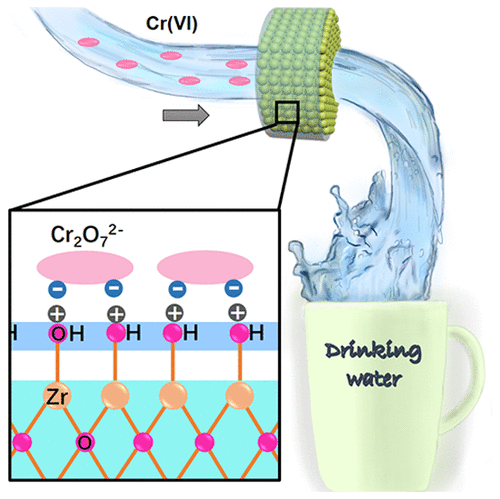当前位置:
X-MOL 学术
›
ACS Appl. Nano Mater.
›
论文详情
Our official English website, www.x-mol.net, welcomes your
feedback! (Note: you will need to create a separate account there.)
Highly Hydroxylated Porous Nanozirconia for Complete Trace Cr(VI) Removal
ACS Applied Nano Materials ( IF 5.3 ) Pub Date : 2020-04-01 , DOI: 10.1021/acsanm.0c00017 Shuying Nong 1 , Wujie Dong 2 , Yi Xiao 1 , Muhammad Sohail Riaz 1 , Chenlong Dong 1 , Yantao Zhao 1 , Zichao Liu 1 , Ruiqi Wang 1 , Fuqiang Huang 1, 2
ACS Applied Nano Materials ( IF 5.3 ) Pub Date : 2020-04-01 , DOI: 10.1021/acsanm.0c00017 Shuying Nong 1 , Wujie Dong 2 , Yi Xiao 1 , Muhammad Sohail Riaz 1 , Chenlong Dong 1 , Yantao Zhao 1 , Zichao Liu 1 , Ruiqi Wang 1 , Fuqiang Huang 1, 2
Affiliation

|
Hexavalent chromium [Cr(VI)] is carcinogenic and mutagenic even at very low concentrations, yet there are still few effective methods to remove Cr(VI) to an ultralow level (<10 ppb). Herein, highly hydroxylated and porous nanozirconia (nano-ZrO2) is prepared through a unique top-down microetching method, which simulates the formation of “Karst Landform” in nature. Specifically, BaZrO3 is utilized as the precursor to be etched to form porous ZrO2, while the particle shape is still maintained in spite of the removal of Ba atoms. X-ray photoelectron spectroscopy confirms that the as-prepared ZrO2 has a surface hydroxyl groups density of up to 72 nm–2, which can be protonated in an acidic solution and hence chelated with electronegative Cr(VI) (Cr2O72–). Thus, a distribution coefficient Kd of 4.16 × 105 mL g–1 is reached, which is the highest value for Cr(VI) adsorption at present. Therefore, this porous nano-ZrO2 shows fast and efficient adsorption of trace Cr(VI) (Cr2O72–) from 2010 to 4.8–5.5 ppb within 60 s, which is far lower than the recommended concentration for drinking water (50 ppb; World Health Organization). With excellent recycling performance and high selectivity, this material can be applied in the terminal treatment system of drinking water. Moreover, the mechanism of this trace adsorption is also well investigated, which may guide future material designs in water treatment and the enrichment of trace elements.
中文翻译:

高度羟基化的多孔纳米氧化锆,可完全去除痕量的Cr(VI)
六价铬[Cr(VI)]即使在非常低的浓度下也具有致癌性和致突变性,但仍很少有有效方法可将Cr(VI)去除至超低水平(<10 ppb)。在此,通过独特的自上而下的微蚀刻方法制备了高度羟基化的多孔纳米氧化锆(nano-ZrO 2),该方法模拟了自然界中“喀斯特地貌”的形成。具体地,将BaZrO 3用作待蚀刻以形成多孔ZrO 2的前体,而尽管去除了Ba原子,但仍保持了颗粒形状。X射线光电子能谱证实,所制备的ZrO 2具有高达72 nm –2的表面羟基密度。,可以在酸性溶液中质子化,因此与带负电的Cr(VI)(Cr 2 O 7 2-)螯合。因此,分配系数K d达到4.16×10 5 mL g –1,这是目前Cr(VI)吸附的最高值。因此,这种多孔的纳米ZrO 2表现出快速有效的痕量Cr(VI)(Cr 2 O 7 2–)从2010年的60秒内降至4.8–5.5 ppb,远低于建议的饮用水浓度(50 ppb;世界卫生组织)。该材料具有出色的循环利用性能和高选择性,可用于饮用水的终端处理系统。此外,这种痕量吸附的机理也得到了很好的研究,可以指导水处理和微量元素富集方面的未来材料设计。
更新日期:2020-04-01
中文翻译:

高度羟基化的多孔纳米氧化锆,可完全去除痕量的Cr(VI)
六价铬[Cr(VI)]即使在非常低的浓度下也具有致癌性和致突变性,但仍很少有有效方法可将Cr(VI)去除至超低水平(<10 ppb)。在此,通过独特的自上而下的微蚀刻方法制备了高度羟基化的多孔纳米氧化锆(nano-ZrO 2),该方法模拟了自然界中“喀斯特地貌”的形成。具体地,将BaZrO 3用作待蚀刻以形成多孔ZrO 2的前体,而尽管去除了Ba原子,但仍保持了颗粒形状。X射线光电子能谱证实,所制备的ZrO 2具有高达72 nm –2的表面羟基密度。,可以在酸性溶液中质子化,因此与带负电的Cr(VI)(Cr 2 O 7 2-)螯合。因此,分配系数K d达到4.16×10 5 mL g –1,这是目前Cr(VI)吸附的最高值。因此,这种多孔的纳米ZrO 2表现出快速有效的痕量Cr(VI)(Cr 2 O 7 2–)从2010年的60秒内降至4.8–5.5 ppb,远低于建议的饮用水浓度(50 ppb;世界卫生组织)。该材料具有出色的循环利用性能和高选择性,可用于饮用水的终端处理系统。此外,这种痕量吸附的机理也得到了很好的研究,可以指导水处理和微量元素富集方面的未来材料设计。











































 京公网安备 11010802027423号
京公网安备 11010802027423号